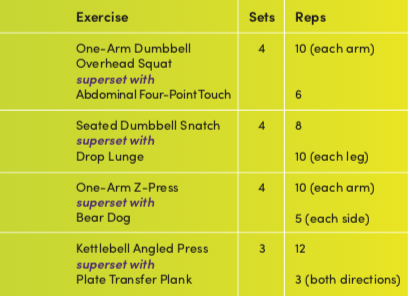
Minimalist Metabolic Conditioning
Get access to everything we publish when you
sign up for Outside+.
There’s something to be said for a pared-down training space devoid of technology, machinery and canned overhead music. With little else to focus on besides your immediate training sesh, your workouts are that much more intense.
This entire workout can take place in a 10-foot space of open floor and uses only a bench, a step and some free weights to get the job done. And because these compound strength moves are arranged in supersets, you’ll keep your heart rate up for a greater percentage of the workout, burning fat while saving time and shaping your muscles.
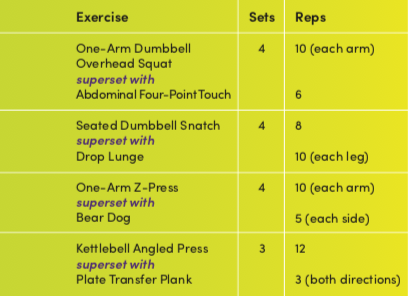
The Minimalist Metabolic Workout
• Choose a weight that is challenging and with which you can complete all the reps indicated.
• Perform all the reps of both moves in each superset back-to-back, then rest 30 to 60 seconds.
• Repeat each superset four times through before moving on to the next.
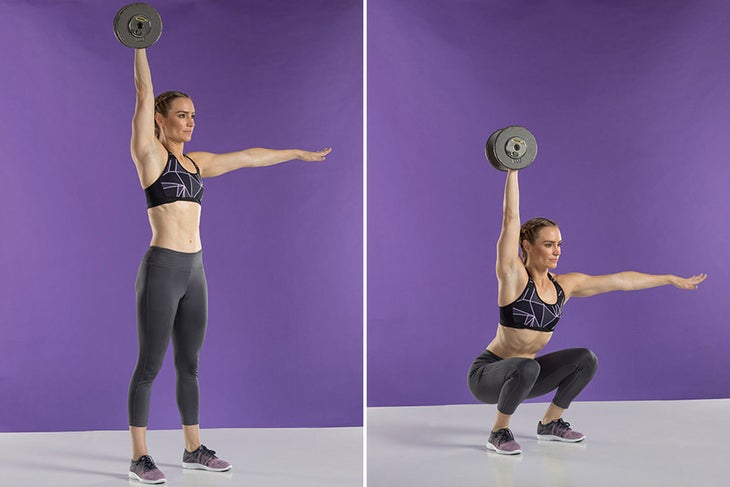
One-Arm Dumbbell Overhead Squat
Muscles Targeted: Quads, glutes, hamstrings, core, obliques, deltoids, lower traps
Doing this overhead movement with one arm at a time challenges your coordination, balance and kinetic awareness. It also strengthens each side of the body individually, correcting imbalances and improving symmetry.
Stand with your feet shoulder-width apart and turned out slightly. Hold a dumbbell in one hand with your palm facing inward and extend your arm straight up over your shoulder. Reach your other arm out to the side for balance. Actively press the weight up toward the ceiling as you kick your hips back and bend your knees to lower into a squat, keeping your hips and shoulders as square as possible. (You might rotate a little.) Drive through your heels and stand up completely before going into the next squat. Complete all reps with one arm before switching sides.
• Tip: Holding the dumbbell with a neutral (palms inward) grip rolls your shoulder into a more ergonomic position when it is extended overhead.
• Make it harder: Use a kettlebell instead of a dumbbell: The offset weight creates more work for your trunk to balance and stabilize the load.
• Make it easier: Squat with a single dumbbell either at shoulder level or in the front rack position.
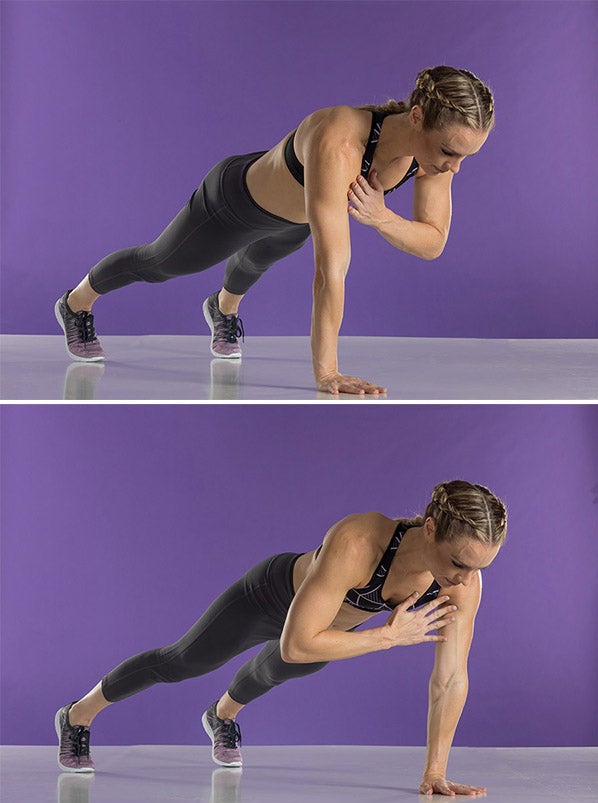
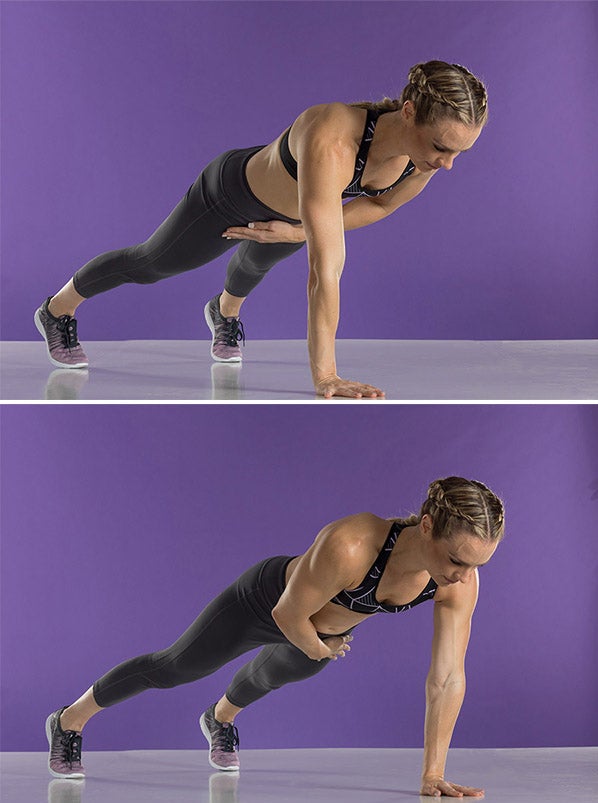
Abdominal Four-Point Touch
Muscles Targeted: Rectus abdominis, obliques, erector spinae, quadratus lumborum
Adding two additional touches in a different area to the standard shoulder-touch move gives your core a new challenge and taxes your muscular endurance.
Get into a plank with your hands directly underneath your shoulders and your head, hips and heels aligned. Spread your feet about shoulder-width apart and brace your core. Slowly lift one hand, briefly touch your opposite shoulder and replace. Repeat with the other hand. Now use the first hand to touch your opposite thigh underneath you and replace. Repeat with the other hand. Touching all four spots equals one rep.
• Tip: Ensure your core is engaged by squeezing your glutes and actively pressing back with your heels.
• Make it harder: Move your feet closer together to create a less-stable platform.
• Make it easier: Spread your feet farther apart to create a wider base of stability, and/or elevate your hands on a bench or step to reduce the amount of bodyweight you have to support.
The slower you do this abdominal four-point-touch, the more you’ll challenge your core strength and endurance.

Seated Dumbbell Snatch
Muscles Targeted: Upper traps, deltoids, rhomboids, erector spinae
As opposed to a standing snatch, this variation eliminates your lower-body activation, forcing your upper body to generate power and speed solo.
Sit on the edge of a bench with your knees and feet together and hold a pair of dumbbells by your sides, palms facing inward. In one powerful motion, project the dumbbells upward by shrugging aggressively. As the weights come to shoulder level, flip your elbows underneath and, without pausing, punch the dumbbells up toward the ceiling, extending your arms quickly. Reverse the steps and return to the start.
• Tip: It is kosher to hinge forward slightly from your hips to help generate power at the start. Just make sure your back stays straight.
• Make it harder: Add a second shoulder press to each rep to doubly fatigue the primary movers.
• Make it easier: Perform the move while standing so your lower body can assist.
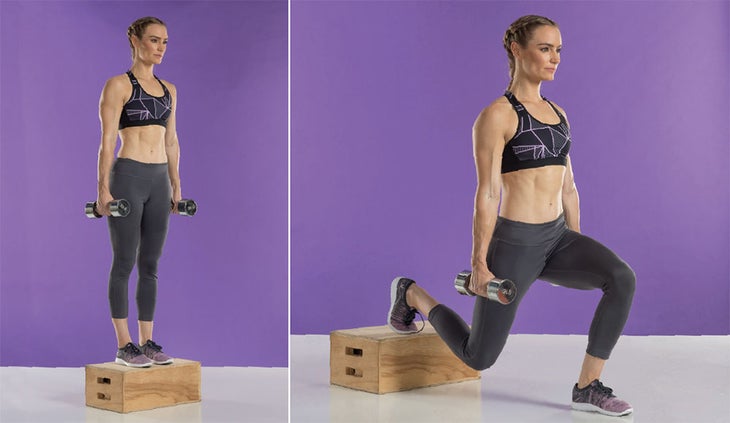
Drop Lunge
Muscles Targeted: Quads, glutes, hamstrings, erector spinae, core
Lunging down off a bench (rather than up onto one) creates much more rapid activation of the quads as they attempt to arrest your forward momentum. Likewise, pushing back up onto the top of the platform requires a greater effort from the quads.
Stand on a low platform or box — about 6 to 8 inches — and hold a set of dumbbells at your sides. Step forward off the platform with one foot and smoothly bend both knees to lunge straight down to ground level. Try to touch your rear knee to the floor without allowing your forward knee to shoot past your toes, then drive off your forward foot and stand back up onto the step. Do all reps on one leg and then switch.
• Tip: To avoid pitching forward, focus your energy and your trailing knee downward, protecting your joints and making your return to the start easier.
• Make it harder: Elevate the step or use a prisoner stance (hands behind your head) while maintaining good posture.
• Make it easier: Perform forward lunges on the floor.
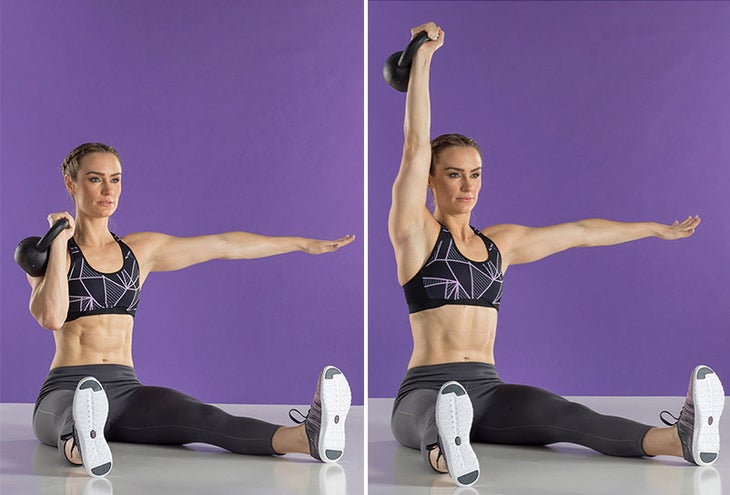
One-Arm Z-Press
Muscles Targeted: Deltoids, core, obliques
Doing a shoulder press while seated on the floor eliminates any momentum typically generated in a standing variation, and the forced neutral spine positioning exposes any shoulder mobility issues.
Sit tall on the floor with your legs extended in front of you and spread shoulder-width apart. Hold a kettlebell in one hand at shoulder level, palm facing inward, and extend your other arm out to the side. Without twisting or leaning, drive the weight up to a full extension overhead. Lower it slowly and repeat. Do all reps on one side before switching.
• Tip: Aim to have your biceps beside your ear. If you can see your arm in your peripheral vision at extension, it’s too far forward.
• Make it harder: Bring your legs closer together, creating more trunk activation to keep your spine straight.
• Make it easier: Perform sitting on a low step with your knees slightly bent.

Bear Dog
Muscles Targeted: Rectus abdominis, obliques, glutes, erector spinae, quadratus lumborum, lower trapezius
This variation on a traditional Bird Dog challenges your core to the max, requires intense focus and concentration, and gives your coordination a good workout, as well.
Start on all fours with your hands beneath your shoulders and your knees beneath your hips. Turn your toes under, then press down into the ground with your hands and your toes to raise your knees 2 to 3 inches off the floor, keeping your spine straight. Brace your core, then raise one arm and the opposite leg to full extension parallel to the floor. Hold for two seconds, then replace. Continue, alternating sides.
• Tip: Maintain stability by flexing your foot and actively pressing your heel toward the back wall while reaching your hand toward the front wall. Simultaneously imagine pulling your planted foot and hand toward each other to further stabilize your trunk.
• Make it harder: Perform from a plank position, which challenges you further to maintain a neutral spine.
• Make it easier: Perform a traditional Bird Dog with your hands and knees on the floor.
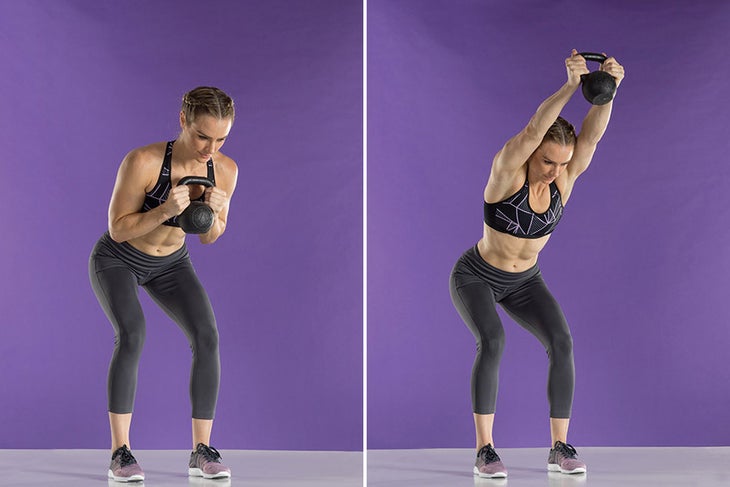
Kettlebell Angled Press
Muscles Targeted: Lower trapezius, medial deltoids, erector spinae
This exercise helps preserve and/or develop good posture because it promotes trunk stability, activates the lower traps (which are often neglected) and strengthens the posterior chain.
Stand with your feet hip-width apart and hold a kettlebell with both hands at your chest, elbows down. Hinge forward at your hips about 45 degrees with your back straight and your shoulders retracted. Hold here as you slowly press the kettlebell upward and forward in line with your body until your arms reach full extension, then slowly pull it back to the start.
• Tip: Rest briefly and reset your position every couple of reps to prevent your form from breaking down.
• Make it harder: Perform on a glute/hamstring developer (GHD) to incorporate more posterior-chain muscles.
• Make it easier: Extend your arms toward the floor at the start, then lift the weight up in an arc to align with your head to reduce the time under tension.
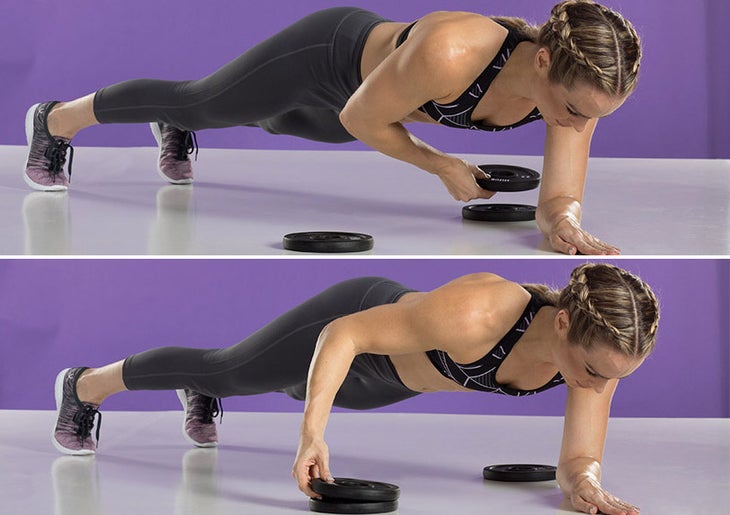
Plate Transfer Plank
Muscles Targeted: Rectus abdominis, obliques
Stabilizing your body in a plank while your arms move around underneath you might not seem like a challenge — until you try it yourself: All the muscles from your heels to your head have to engage in some way to make this exercise happen.
Pile three to four small weight plates (2.5 to 5 pounds) to your left side and get into plank with your elbows directly underneath your shoulders and your head, hips and heels aligned. Reach across with your right hand and take a plate from the pile, bringing it to the right side and placing it down. Repeat until all the plates have been moved, then switch arms and return them to the start to complete one rep.
• Tip: After each rep, plant your knees down for a few seconds and then return to plank and re-establish your form.
• Make it harder: Move the plates farther away, creating a longer reach and demanding more of your core to resist extension and rotation.
• Make it easier: Use fewer plates and place them closer to your body.
The Path of Greatest Resistance
Until recently, studies on the effects of high-intensity interval training have been limited to aerobic exercise. However, researchers from Western State Colorado University wanted to see if HIIT resistance exercise (HIIT-RE) could proffer the same benefits. Study participants were assigned to one of three groups: a control group that did no exercise, a HIIT-RE group or a group that performed moderate-intensity resistance exercise (MI-RE).
After six weeks, both the HIIT-RE and MI-RE groups reported decreased body fat and blood pressure, but the HIIT-RE group was shown to be as effective — and in some instances more effective — than MI-RE at improving metabolic health and muscular fitness — in half the time: The HIIT-RE group’s workouts took half as long to complete, and in terms of one-rep max, the HIIT-RE group experienced significant gains in only three weeks, versus the six weeks it took for the MI-RE to achieve similar results. Furthermore, only the HIIT-RE group showed a significant decrease in cholesterol.
Published at Thu, 17 Feb 2022 01:56:22 -0800






